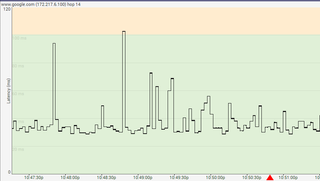What are latency and ping and what do they mean for gaming?
Quality over quantity.

Modern PC gaming has several requirements, including a broadband network connection. Most internet service providers (ISP’s) sell their service on different tiers, with the faster speed commanding the higher price. With heavy marketing from internet providers users often think that the faster internet speed will benefit their gaming, but unless the majority of the available bandwidth across the network is being utilized, there will not be a benefit from a faster speed. With PC gaming more dependent on the continuous flow of data, rather than raw bandwidth, the goal should be for a higher quality connection, as there will be little expected benefit from a faster download speed.
Latency refers to the time required for a signal to go from a transmitter to a receiver, although some use latency to refer to the round trip from transmitter to receiver, and back to receiver, namely the round trip. When data is downloaded, while it hopefully seems instant, it does have a finite speed whether through the air (at the speed of light or any other radio wave), or at a slower speed when traveling through a copper wire (where the theoretical maximum is 2/3rd’s the speed of light, although that would be for an ideal wire). A lower latency is preferred, especially for gaming, although while ISP’s advertise their download speeds ad nauseum, none indicate their latency. When the latency gets high while gaming, this is seen as lag, which is the annoying delay between player input, and response of the game, and often manifests as game stuttering, low frame rates, and overall poor performance- basically the online game grinds to crashing halt.
Ping often gets used synonymously and interchanged with latency, but while it is related, this is not correct. The term has its roots in active sonar, with a ping being the pulse of sound sent out, followed by listening for its reflection to come back. Ping in computers actually refers to the signal sent out across the network to another computer, and this other computer then sends its own signal back, which is another ping. The measurement of this round trip then gets referred to as latency.
Now that we have a better understanding of latency, lag and ping, let’s look at what it means. While we all want the lowest latency, it is recommended to have less than 75 to 100 milliseconds for a good gaming connection. While many of us are stuck with cable connections, in general a fiber optic connection is faster than a cable one, as light in a wire will travel faster than electricity in copper as discussed above, and can have a ping times in the single digits. On the other hand, trying to game on a cellular connection can be painful as on newer 4G connections the times are 50 to 150 millisecs, while 3G wireless is downright pokey with latencies of 100 to 350 millisecs.
While the choice of internet connection can affect the latency, there are also other variables, including an Ethernet or Wi-Fi connection, and congestion on the network. Each network is unique based on the networking hardware and the location. Ideally ping should be measured for the individual setup via software such as PingPlotter 5, so the network can be tuned to provide the highest quality connection. Just remember that the solution is not always more bandwidth, but rather to roll up your sleeves, and fine tune the network to provide a high quality connection for gaming traffic so that the network is lag free.
The biggest gaming news, reviews and hardware deals
Keep up to date with the most important stories and the best deals, as picked by the PC Gamer team.
Most Popular


